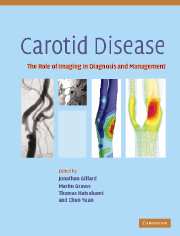Book contents
- Frontmatter
- Contents
- List of contributors
- List of abbreviations
- Introduction
- Background
- Luminal imaging techniques
- 9 Conventional carotid Doppler ultrasound
- 10 Conventional digital subtraction angiography for carotid disease
- 11 Magnetic resonance angiography of the carotid artery
- 12 Computed tomographic angiography of carotid artery stenosis
- 13 Cost-effectiveness analysis for carotid imaging
- Morphological plaque imaging
- Functional plaque imaging
- Plaque modelling
- Monitoring the local and distal effects of carotid interventions
- Monitoring pharmaceutical interventions
- Future directions in carotid plaque imaging
- Index
- References
13 - Cost-effectiveness analysis for carotid imaging
from Luminal imaging techniques
Published online by Cambridge University Press: 03 December 2009
- Frontmatter
- Contents
- List of contributors
- List of abbreviations
- Introduction
- Background
- Luminal imaging techniques
- 9 Conventional carotid Doppler ultrasound
- 10 Conventional digital subtraction angiography for carotid disease
- 11 Magnetic resonance angiography of the carotid artery
- 12 Computed tomographic angiography of carotid artery stenosis
- 13 Cost-effectiveness analysis for carotid imaging
- Morphological plaque imaging
- Functional plaque imaging
- Plaque modelling
- Monitoring the local and distal effects of carotid interventions
- Monitoring pharmaceutical interventions
- Future directions in carotid plaque imaging
- Index
- References
Summary
Introduction
The pooled analysis of data from large randomized trials such as the North American symptomatic carotid trial (NASCET) and the European carotid surgery trial (ECST) has confirmed the significant benefits of surgery for severe (70–99%) carotid stenosis in recently symptomatic patients (Rothwell et al., 2003). Moreover, in asymptomatic patients, 60% stenosis is generally used as a cut-off for surgery based on the results of the asymptomatic carotid atherosclerosis study (ACAS) (Endarterectomy for asymptomatic carotid artery stenosis. Executive Committee for the Asymptomatic Carotid Atherosclerosis Study, 1995). In most of these trials, intraarterial digital subtraction angiography (DSA) has been used to measure the degree of stenosis and as such, remains the gold standard method in terms of diagnostic accuracy, against which alternative imaging modalities need to be validated. Concerns about the small but potentially significant risks of neurological complications associated with DSA have generated a strong trend toward the use of noninvasive modalities such as Doppler ultrasound (DUS), magnetic resonance angiography (MRA) or computerized tomography angiography (CTA) alone or in combination (Dawson et al., 1997; Athanasoulis and Plomaritoglou, 2000; Long et al., 2002).
In current clinical practice, there is ongoing controversy whether noninvasive strategies can replace DSA as the preoperative imaging modality of choice (Derdeyn and Powers, 1996; Davis and Donnan, 2003). This lack of consensus is reflected by a wide variety of existing practices worldwide (Dawson et al., 1997; Athanasoulis and Plomaritoglou, 2000; Long et al., 2002; Willinsky et al., 2003).
Keywords
- Type
- Chapter
- Information
- Carotid DiseaseThe Role of Imaging in Diagnosis and Management, pp. 166 - 179Publisher: Cambridge University PressPrint publication year: 2006



